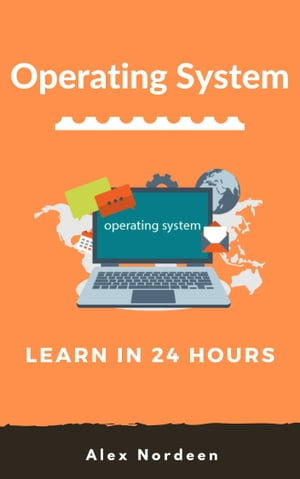
At a Glance
ePUB
eBook
$17.47
or 4 interest-free payments of $4.37 with
Instant Digital Delivery to your Booktopia Reader App
Read on
Table Of Content
Chapter 1: What is Operating System? Explain Types of OS, Features and Examples
- What is an Operating System?
- History Of OS
- Examples of Operating System with Market Share
- Types of Operating System (OS)
- Functions of Operating System
- Features of Operating System (OS)
- Advantage of using Operating System
- Disadvantages of using Operating System
- What is Kernel in Operating System?
- Features of Kennel
- Difference between Firmware and Operating System
- Difference between 32-Bit vs. 64 Bit Operating System
Chapter 2: What is Semaphore? Binary, Counting Types with Example
- What is Semaphore?
- Characteristic of Semaphore
- Types of Semaphores
- Example of Semaphore
- Wait and Signal Operations in Semaphores
- Counting Semaphore vs. Binary Semaphore
- Difference between Semaphore vs. Mutex
- Advantages of Semaphores
- Disadvantage of semaphores
Chapter 3: Components of Operating Systems
- What are OS Components?
- File Management
- Process Management
- I/O Device Management
- Network Management
- Main Memory management
- Secondary-Storage Management
- Security Management
- Other Important Activities
Chapter 4: Microkernel in Operating System: Architecture, Advantages
- What is Kernel?
- What is Microkernel?
- What is a Monolithic Kernel?
- Microkernel Architecture
- Components of Microkernel
- Difference Between Microkernel and Monolithic Kernel
- Advantages of Microkernel
- Disadvantage of Microkernel
Chapter 5: System Call in OS (Operating System): What is, Types and Examples
- What is System Call in Operating System?
- Example of System Call
- How System Call Works?
- Why do you need System Calls in OS?
- Types of System calls
- Rules for passing Parameters for System Call
- Important System Calls Used in OS
Chapter 6: File Systems in Operating System: Structure, Attributes, Type
- What is File System?
- Objective of File management System
- Properties of a File System
- File structure
- File Attributes
- File Type
- Functions of File
- Commonly used terms in File systems
- File Access Methods
- Space Allocation
- File Directories
- File types- name, extension
Chapter 7: Real-time operating system (RTOS): Components, Types, Examples
- What is a Real-Time Operating System (RTOS)?
- Why use an RTOS?
- Components of RTOS
- Types of RTOS
- Terms used in RTOS
- Features of RTOS
- Factors for selecting an RTOS
- Difference between in GPOS and RTOS
- Applications of Real Time Operating System
- Disadvantages of RTOS
Chapter 8: Remote Procedure Call (RPC) Protocol in Distributed System
- What is RPC?
- Types of RPC
- RPC Architecture
- How RPC Works?
- Characteristics of RPC
- Features of RPC
- Advantages of RPC
- Disadvantages of RPC
Chapter 9: CPU Scheduling Algorithms in Operating Systems
- What is CPU Scheduling?
- Types of CPU Scheduling
- Important CPU scheduling Terminologies
- CPU Scheduling Criteria
- Interval Timer
- What is Dispatcher?
- Types of CPU scheduling Algorithm
- First Come First Serve
- Shortest Remaining Time
- Priority Based Scheduling
- Round-Robin Scheduling
- Shortest Job First
- Multiple-Level Queues Scheduling
- The Purpose of a Scheduling algorithm
Chapter 10: Process Management in Operating System: PCB in OS
- What is a Process?
- What is Process Management?
- Process Architecture
- Process Control Blocks
- Process States
- Process Control Block(PCB)
Chapter 11: Introduction to DEADLOCK in Operating System
- What is Deadlock?
- Example of Deadlock
- What is Circular wait?
- Deadlock Detection
- Deadlock Prevention:
- Deadlock Avoidance
- Difference Between Starvation and Deadlock
- Advantages of Deadlock
- Disadvantages of Deadlock method
Chapter 12: FCFS Scheduling Algorithm: What is, Example Program
- What is First Come First Serve Method?
- Characteristics of FCFS method
- Example of FCFS scheduling
- How FCFS Works? Calculating Average Waiting Time
- Advantages of FCFS
- Disadvantages of FCFS
Chapter 13: Paging in Operating System(OS)
- What is Paging?
- Example
- What is Paging Protection?
- Advantages of Paging
- Disadvantages of Paging
- What is Segmentation?
- Advantages of a Segmentation method
- Disadvantages of Segmentation
Chapter 14: Livelock: What is, Example, Difference with Deadlock
- What is Livelock?
- Examples of Livelock
- What Leads to Livelock?
- What is Deadlock?
- Example of Deadlock
- What is Starvation?
- Difference Between Deadlock, Starvation, and Livelock
Chapter 15: Inter Process Communication (IPC)
- What is Inter Process Communication?
- Approaches for Inter-Process Communication
- Why IPC?
- Terms Used in IPC
- What is Like FIFOS and Unlike FIFOS
Chapter 16: Round Robin Scheduling Algorithm with Example
- What is Round-Robin Scheduling?
- Characteristics of Round-Robin Scheduling
- Example of Round-robin Scheduling
- Advantage of Round-robin Scheduling
- Disadvantages of Round-robin Scheduling
- Worst Case Latency
Chapter 17: Process Synchronization: Critical Section Problem in OS
- What is Process Synchronization?
- How Process Synchronization Works?
- Sections of a Program
- What is Critical Section Problem?
- Rules for Critical Section
- Solutions To The Critical Section
Chapter 18: Process Scheduling: Long, Medium, Short Term Scheduler
- What is Process Scheduling?
- Process Scheduling Queues
- Two State Process Model
- Scheduling Objectives
- Type of Process Schedulers
- Long Term Scheduler
- Medium Term Scheduler
- Short Term Scheduler
- Difference between Schedulers
- What is Context switch?
Chapter 19: Priority Scheduling Algorithm: Preemptive, Non-Preemptive EXAMPLE
- What is Priority Scheduling?
- Types of Priority Scheduling
- Characteristics of Priority Scheduling
- Example of Priority Scheduling
- Advantages of priority scheduling
- Disadvantages of priority scheduling
Chapter 20: Memory Management in OS: Contiguous, Swapping, Fragmentation
- What is Memory Management?
- Why Use Memory Management?
- Memory Management Techniques
- What is Swapping?
- What is Memory allocation?
- Partition Allocation
- What is Paging?
- What is Fragmentation?
- What is Segmentation?
- What is Dynamic Loading?
- What is Dynamic Linking?
- Difference Between Static and Dynamic Loading
- Difference Between Static and Dynamic Linking
Chapter 21: Shortest Job First (SJF): Preemptive, Non-Preemptive Example
- What is Shortest Job First Scheduling?
- Characteristics of SJF Scheduling
- Non-Preemptive SJF
- Preemptive SJF
- Advantages of SJF
- Disadvantages/Cons of SJF
Chapter 22: Virtual Memory in OS: What is, Demand Paging, Advantages
- What is Virtual Memory?
- Why Need Virtual Memory?
- How Virtual Memory Works?
- What is Demand Paging?
- Types of Page Replacement Methods
- FIFO Page Replacement
- Optimal Algorithm
- LRU Page Replacement
- Advantages of Virtual Memory
- Disadvantages of Virtual Memory
Chapter 23: Banker's Algorithm in Operating System [Example]
- What is Banker's Algorithm?
- Banker's Algorithm Notations
- Example of Banker's algorithm
- Characteristics of Banker's Algorithm
- Disadvantage of Banker's algorithm
Read on
ISBN: 1230005675029
Published: 19th July 2022
Format: ePUB
Language: English
Publisher: Guru99





















